Temenos Banking Cloud Scales to Record High Transactions with MongoDB Atlas and Microsoft Azure
Banking used to be a somewhat staid, hyper-conservative industry, seemingly evolving over eons. But the emergence of Fintech and pure digital players in the market paired with alternatives in technology is transforming the industry. The combination of MACH, BIAN and composable designs enables true innovation and collaboration within the banking sector, and the introduction of cloud services makes these approaches even easier to implement.
Just ask Temenos, the world's largest financial services application provider, providing banking for more than 1.2 billion people. Temenos is leading the way in banking software innovation and offers a seamless experience for their client community in over 150 countries. Temenos embraces a cloud-first, microservices-based infrastructure built with MongoDB, giving customers flexibility, while also delivering significant performance improvements. Financial institutions can embed Temenos components, like Pay-as-you-go, which delivers new functionality to their existing on-premises environments, on their own cloud deployments or through a full banking as a service experience with Temenos Transact powered by MongoDB on various cloud platforms. This new MongoDB-based infrastructure enables Temenos to rapidly innovate on its customers' behalf, while improving security, performance, and scalability.
Fintech, payments and core banking
Temenos and MongoDB joined forces in 2019 to investigate the path toward data in a componentized world. Over the past few years, our teams have collaborated on a number of new, innovative component services to enhance the Temenos product family, and several banking clients are now using those components in production. However, the approach we've taken allows banks to upgrade on their own terms. By putting components “in front” of the Temenos Transact platform, banks can start using a componentization solution without disrupting their ability to serve existing customer requirements. From May 2023 onwards, banks will have the capability to deploy Temenos Infinity microservices as well as the core banking Temenos Transact exclusively on the modern database from MongoDB and derive even more value.
Making the composable approach even more valuable, Temenos implemented their new data backend firmly based on JSON and the document model. MongoDB allows fully transparent access to data and the exploitation of additional features of the modern database. These features include Atlas Search, application-driven analytics, and AI through workload isolation. Customers also benefit from the geographic distribution of data based solely on the customer requirements, be it in a single country driven by sovereignty requirements or distributed across continents to ensure always-on and best possible data access and speed for trading.
Improved performance and scale
In contrast to the retail-centric benchmark last year, the approach this time was to test broader functionality and include more diverse business areas – all while increasing the transaction volume by 50%.
The benchmark scenario simulated a client with 50 million retail customers, 100 million accounts and a Banking-as-a-Service (BaaS) offering for 10 brands and 50 million embedded finance customers on a single cloud instance.
In the test, Temenos Banking Cloud processed 200 million embedded finance loans and 100 million retail accounts at a record-breaking 150,080 transactions per second. In doing so, Temenos proved its robust and scalable platform can support banks’ business models for growth through BaaS or distributing their products themselves. The benchmark included not just core transaction processing, but a composed solution combining payments, financial crime mitigation (FCM), a data hub, and digital channels.
"No other banking technology vendor comes close to the performance and scalability of Temenos Banking Cloud. We consistently invest more in cloud technologies and have more banks live with core banking in the cloud than any of our peers. With global non-cash transaction volumes skyrocketing in response to fast-emerging trends like BaaS, banks need a platform that allows them to elastically scale based on business demand, provide composable capabilities on-demand at a low cost, while reducing their environmental impact. This benchmark with Microsoft and MongoDB proves the capability of Temenos’ platform to power the world’s biggest banks and their BaaS offerings with hundreds of millions of customers, efficiently and sustainably in the cloud." Tony Coleman, Chief Technology Officer, Temenos
This solution landscape reflects an environment where everyone on the planet runs two banking transactions a day on a single bank. This throughput should cater to any Tier 1 banking deployment, in size and performance, and cover any future growth plans that they have.
Below are the transaction details that comprise the actual benchmark mix. As mentioned above it is a broad mix of different functionalities behaving like a retail bank and a fintech institute, which provides multiple product brands, e.g. cards for different retails.
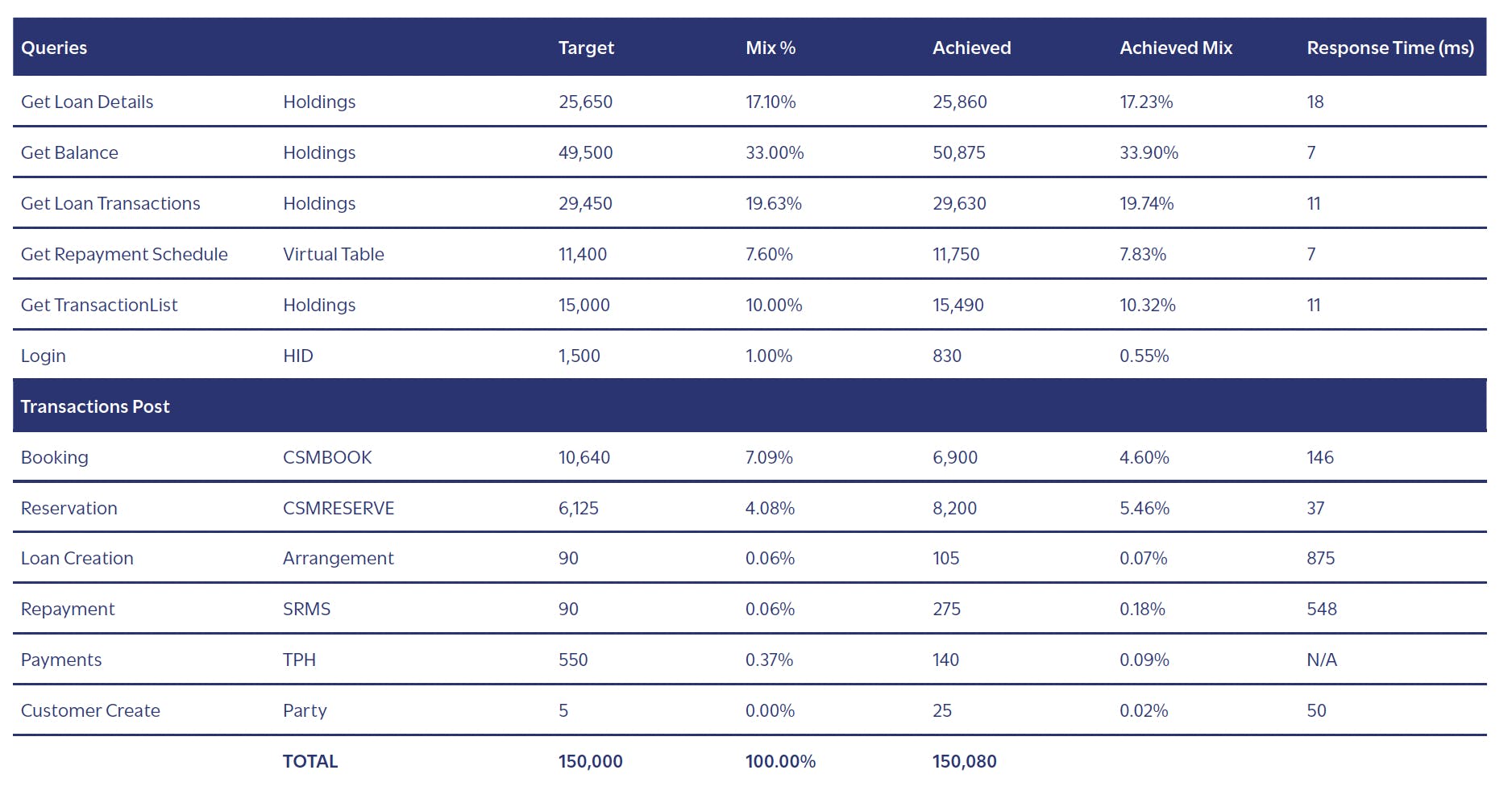
Besides the sheer performance of the benchmark, the ESG footprint of the overall landscape shrunk again versus last year’s configuration as the MongoDB Atlas environment was the sole database and no secondary systems were required.
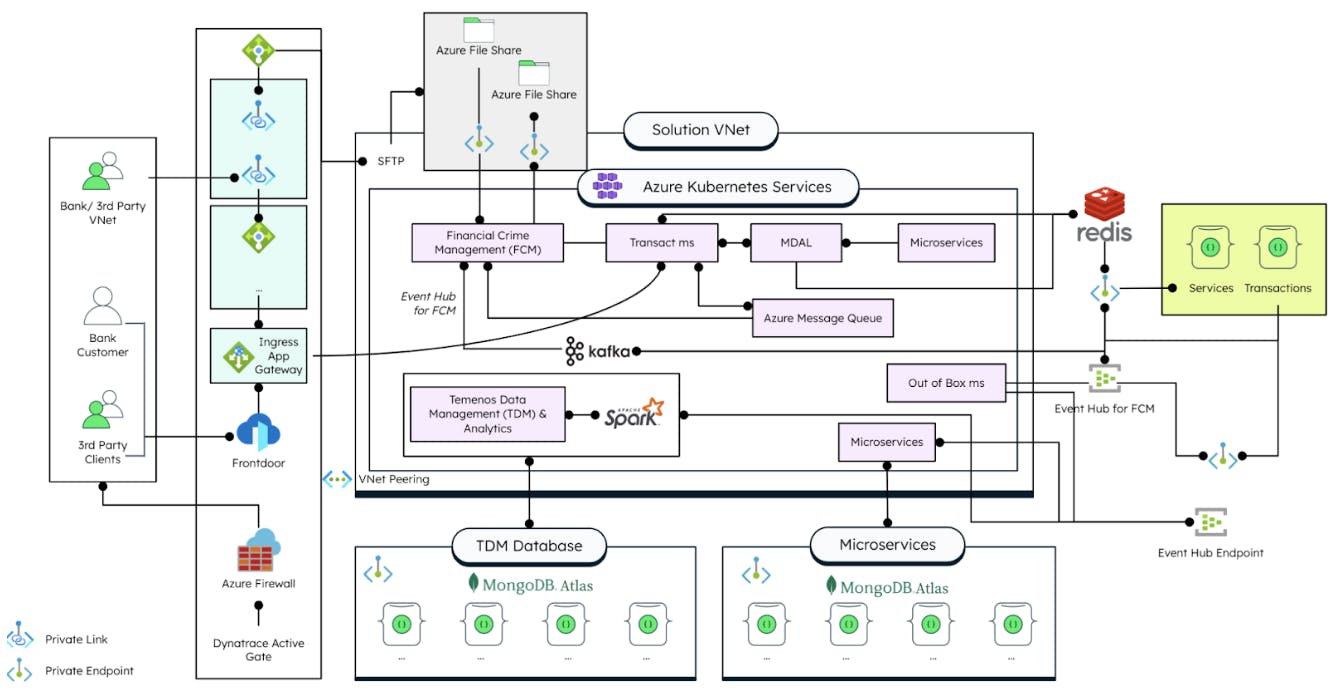
The JSON advantage
Temenos made significant engineering efforts to decapsulate the data layer, which was previously stored as PIC, and make JSON formatted data available to their user community. MongoDB was designed from its inception to be a database focused on delivering a great development experience. JSON’s ubiquity made it the obvious choice for representing data structures in MongoDB’s document data model. Below you can see how Temenos Transact stores data vs Oracle or MSSQL vs MongoDB. Temenos and MongoDB have an aligned data store – Temenos Transact application code operates on documents (JSON) and MongoDB stores documents in JSON in one place, making it the perfect partnership.
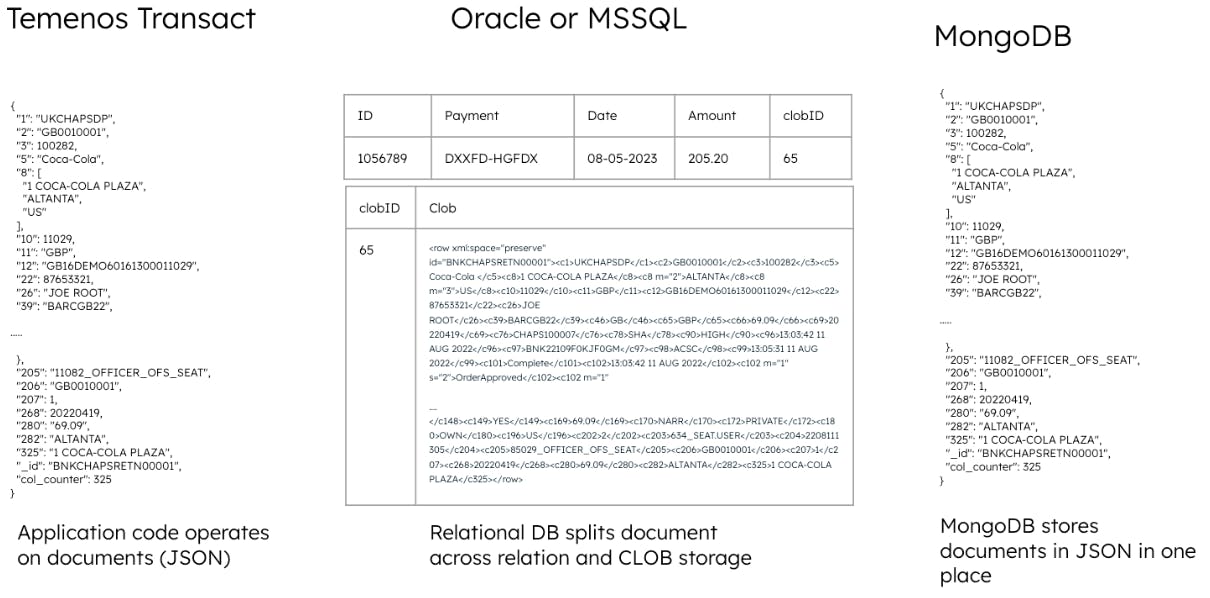
MongoDB enables the user community through its concept of additional nodes in the replica set to align further secondary applications integrated into the same database without interrupting and disturbing the transactional workload of Temenos Transact. The regular occurring challenge with legacy relational database management systems (RDBMS) where secondary applications suddenly have unexpected consequences to the primary application is a problem of the past with MongoDB.
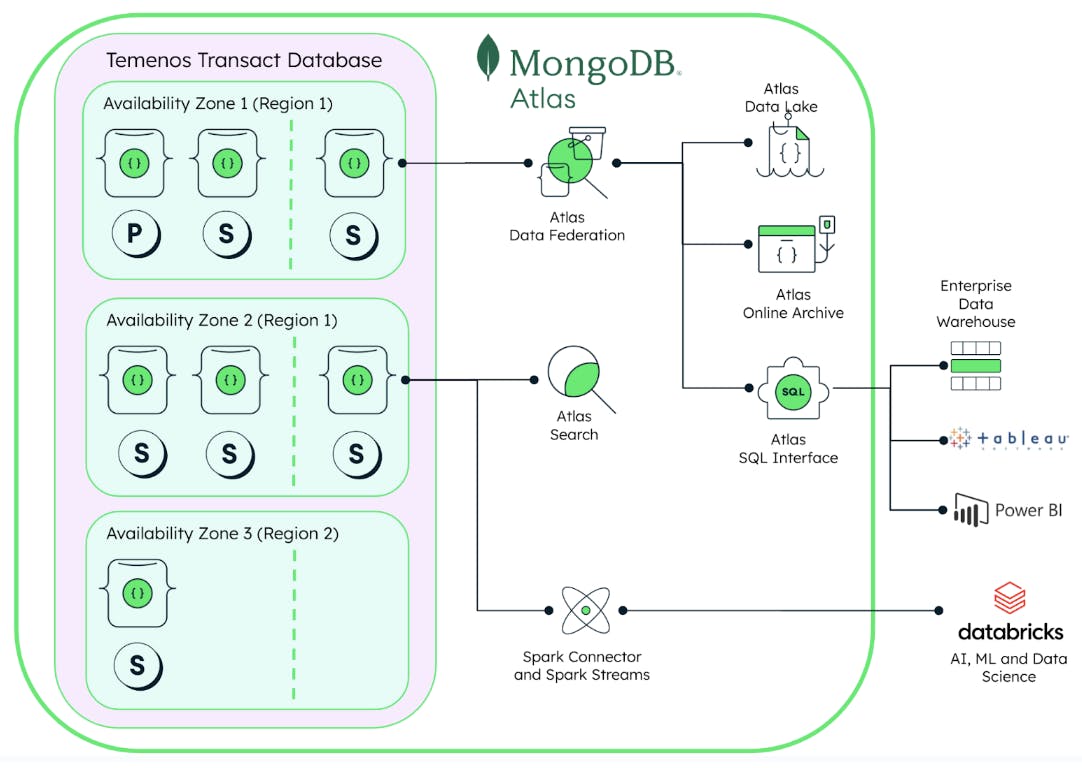
MongoDB Atlas will operate in most cases in three availability zones, where two zones are located in the same region for pure availability and a single node is located in a remote region for disaster recovery. This environment provides the often required RPO/RTO “0” while delivering unprecedented performance. Two nodes in each of the first availability zones provision the transactional replica set and ensure the consistency and operation of the Temenos Transact application. In each availability zone, a third isolated workload node is co-located with the same data set as the other two nodes but is excluded from the transactional processing. These isolated workload nodes provide capacity for additional functionalities. In the example above, one node provides access to the MongoDB Atlas Federation and a second node provides the interface for MongoDB Atlas Search. As the nodes store data in near real-time – replication is measured in sub milliseconds as they are in the same availability zone – this allows exciting new capabilities like real-time large language model (LLM), e.g. ChatGPT, or machine learning connecting to a Databricks lake house. The design is discussed in more detail in this article.
The below diagram shows a typical configuration for such a cluster setup in the European market for Microsoft Azure: one availability zone in Zurich, one availability zone in Geneva, and an additional node out of both in Ireland. Additionally, we configured isolated workloads in Zurich and Geneva. MongoDB Atlas allows the creation of such a cluster within seconds, configured to the specific requirements of the solution deployed.
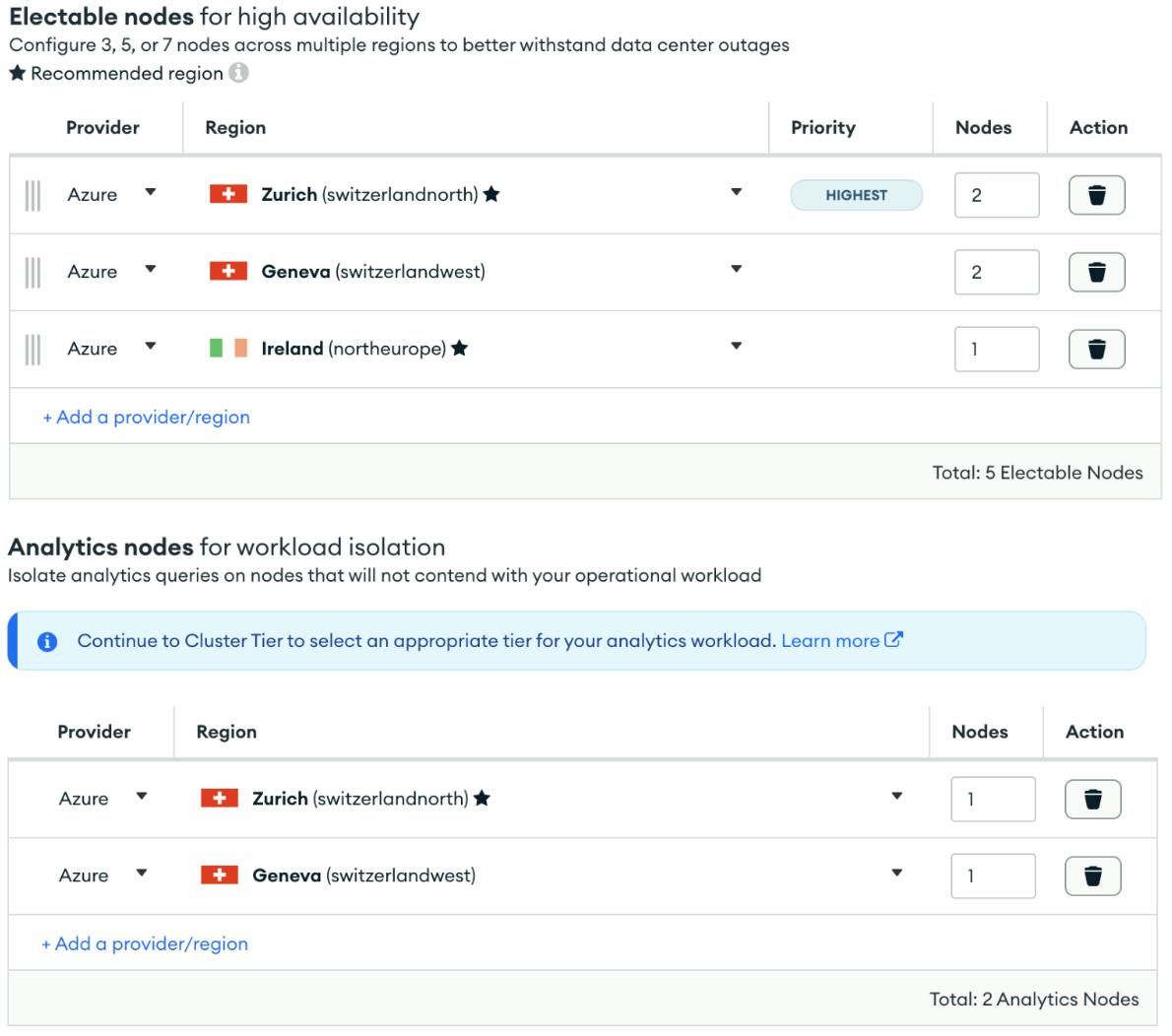
Should the need arise, MongoDB can have up to 50 nodes in a single replica set so for each additional isolated workload, one or more nodes can be made available when and where needed. Even at locations beyond the initial three chosen!
For this benchmark the use of a MongoDB Atlas cluster M600 was utilized which was oversized based on the CPU utilization of 20-60% depending on the node type. Looking backward a smaller MongoDB Atlas M200 would have been easily sufficient. Nonetheless MongoDB Atlas delivered the needed database performance with one third of the resources of last year's result, but delivering 50% more throughput. Additionally MongoDB Atlas performed two times faster in throughput per transaction (measured in milliseconds).
Signed, sealed, and delivered. This benchmark gives clients peace of mind that the combination of core banking with Temenos Transact and MongoDB is ready to support the needs of even the largest global banks.
While thousands of banks rely on MongoDB for many parts of their operations ranging from login management and online banking, to risk and treasury management systems, Temenos' adoption of MongoDB is a milestone. It shows that there is significant value in moving from a legacy database technology to MongoDB, allowing faster innovation, eliminating technical debt along the way, and simplifying the landscape for financial institutions, their software vendors, and service providers.
PS: We know benchmarks can be deceiving and every scenario in each organization is different. Having been in the benchmark business for a long time, you should never trust just ANY benchmark. In fact, my colleague, MongoDB distinguished engineer John Page, wrote a great blog about how to benchmark a database.
Thank you to Ainhoa Múgica and Karolina Ruiz Rogelj for their contributions to this post.
If you would like to learn more about how you can use MongoDB to move towards a composable system, architecting for real-time adaptability, scalability, and resilience, take a look at the below resources: